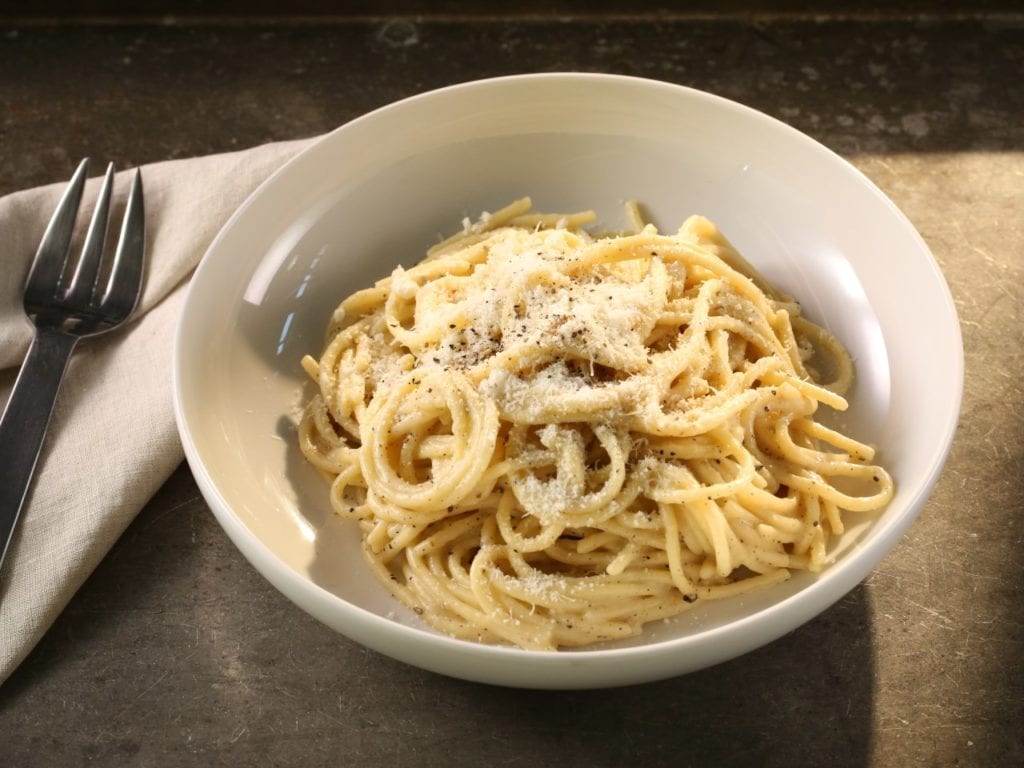
Cacio e Pepe
Pasta water is a magical thing. Packed with starchy goodness, this leftover cooking liquid can transform ordinary store-bought pasta into something special. One of the most famous dishes to exploit its marvels hails from Rome and goes by the name cacio e pepe, which roughly translates to "cheese and pepper." It's one of the best pasta dishes there is. Here's how I do it. A note on cooking pasta: Few things in the culinary realm are worse than overcooked pasta, so keep an eye on it. If it’s not ready the first time you taste it, keep checking every 30 seconds thereafter. This recipe first appeared in Season 1 of Good Eats: Reloaded.

ACTIVE TIME: 40 minutes
TOTAL TIME: 40 minutes
Yield: 4 servings
Software
- 3 cups finely grated pecorino Romano cheese
- 1 1/2 cups finely grated Parmesan cheese
- 1/3 cup extra-virgin olive oil
- 2 tablespoons
freshly ground black pepper , plus more for serving if desired - 1 pound dry spaghetti
- 2 tablespoons
kosher salt - Cold water, for cooking the pasta
Procedure
- Combine 2 3/4 cups (100 grams) of the Pecorino, all of the Parmesan, the olive oil, and the 2 tablespoons (14 grams) pepper in a large, deep mixing bowl. Work the ingredients together with the back of a wooden spoon until a thick paste forms, 2 to 3 minutes. Set aside while you cook the pasta.
- Combine the pasta and salt in a 3-quart, straight-sided sauté pan. Add enough cold water to just barely cover the pasta and measure 1 1/2 inches deep total. Cover, set over medium-high heat, and bring to a boil, about 10 minutes.
- When the water reaches a boil, remove the lid and decrease the heat to medium to maintain a simmer. Stir the pasta every minute or so, making sure the ends of the noodles stay submerged and that they aren't sticking together.
- After the pasta has been simmering for 5 minutes, ladle 1 cup of the cooking water into a measuring cup, then slowly drizzle 3/4 cup of that water into the cheese paste, mixing until smooth, about 2 minutes.
- At this point, check the pasta for doneness; you want it to be just barely al dente as there'll be some carryover cooking in the next step. If it isn’t al dente, continue to check on the pasta every 30 seconds until you are happy with it.
- Use tongs to lift the pasta out of the cooking water and allow to briefly drain before adding to the bowl with the cheese paste. Grasp the pasta with the tongs and stir and toss vigorously for 2 minutes. (Really use a lot of elbow grease here — this is not a light toss.) The pasta will continue to release starch and the sauce will emulsify. After around 1 1/2 minutes, you will see cheesy water magically transform into a proper sauce. If you find your sauce clumping, add a bit more of the reserved pasta water and continue working the pasta.
- Portion the pasta into four bowls, top with the remaining Pecorino and additional black pepper, if desired, and serve immediately.